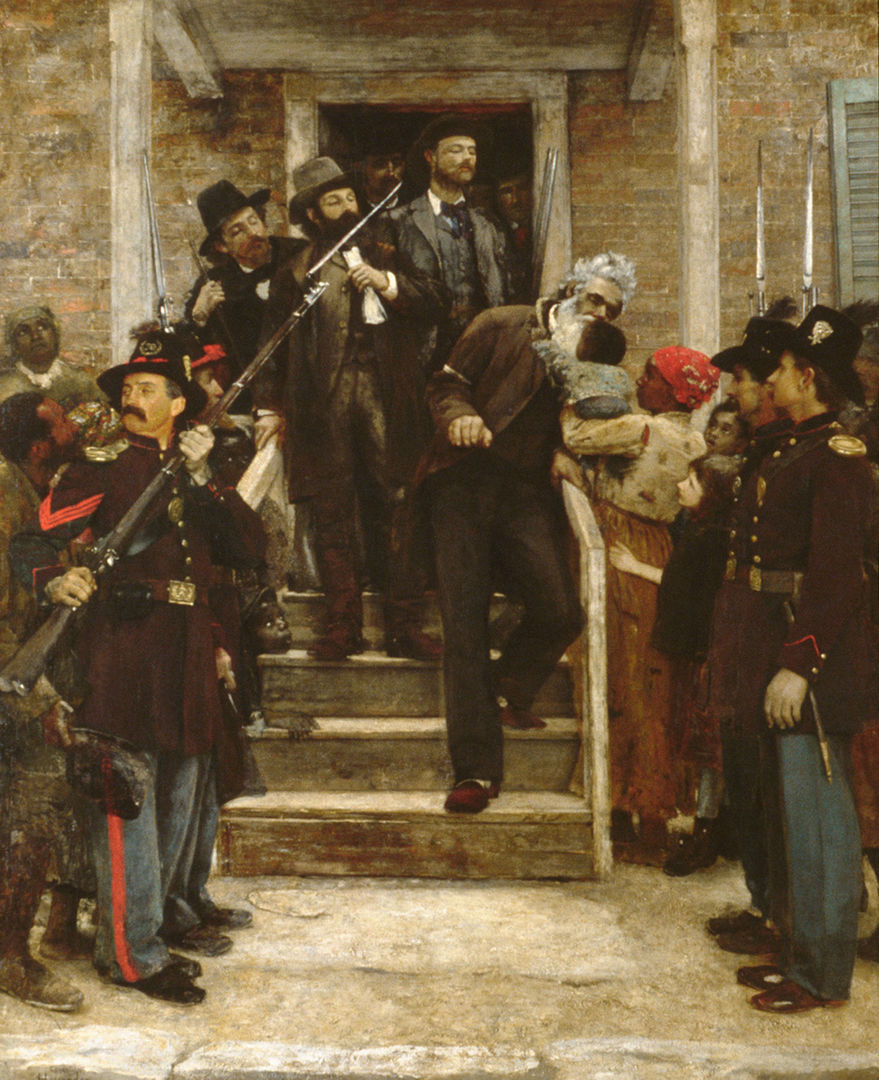Point of View in Print and Paint

Thomas Hovenden (American, 1840–1895). The Last Moments of John Brown, 1882–84. Oil on canvas, 77 3/8 x 66 1/4 in. (196.5 x 168.3 cm). The Metropolitan Museum of Art, New York, Gift of Mr. and Mrs. Carl Stoeckel, 1897 (97.5)
Collection Area: American Art
Subject Areas: English Language Arts, U.S. History, Visual Arts
Grades: Middle School
Topic/Theme: Art as a Primary Resource, Stories in Art
Goals
Students will be able to:
- identify ways the artist uses color, composition, and the subjects' poses to convey viewpoint;
- cite evidence from texts that support interpretations of each document; and
- integrate content presented in diverse media and formats.
National Learning Standards
English Language Arts
NL-ENG.K-12.4 Communication Skills
NL-ENG.K-12.6 Applying Knowledge
U.S. History
NSS-USH.5-12.5 Era 5: Civil War and Reconstruction (1850–1877)
Visual Arts
NA-VA.5-8.4 Understanding the Visual Arts in Relation to History and Cultures
NA-VA.5-8.6 Making Connections between Visual Arts and Other Discipline
Common Core State Standards
English Language Arts
CCSS.ELA-Literacy.CCRA.R.1 Read closely to determine what the text says explicitly and to make logical inferences from it; cite specific textual evidence when writing or speaking to support conclusions drawn from the text.
CCSS.ELA-Literacy.CCRA.R.7 Integrate and evaluate content presented in diverse media and formats, including visually and quantitatively, as well as in words.
CCSS.ELA-Literacy.RH.6-8.1 Cite specific textual evidence to support analysis of primary and secondary sources.
CCSS.ELA-Literacy.CCRA.W.1 Write arguments to support claims in an analysis of substantive topics or texts using valid reasoning and relevant and sufficient evidence.
Questions for Viewing
- What appears to be happening in this painting? What do you see that makes you say that?
- Clothing and accessories can provide clues about a person's role or status in a community. Select one figure to observe closely. Describe his or her clothing and accessories. What might you infer about this figure?
- Look back at the figure you selected. What do you notice about his or her expression and body language? What might this suggest about his or her outlook on the event and relationship to the central figure?
- In 1859 John Brown (the figure kissing a baby in the center of the composition), an impassioned abolitionist, planned and led a raid on a federal arsenal in Harper's Ferry, Virginia. His efforts to secure weapons to support the abolitionist cause went awry, leading to his arrest and eventual execution. What do you think the artist hoped to convey about John Brown? [Tip: Consider the artist's use of color, composition, and the subjects' poses.]
Activity
Activity Setting: Classroom
Materials: Class sets of "Brown of Ossawatomie" and "Execution of John Brown"
Subject Areas: English Language Arts, U.S. History
Duration: 45–60 minutes
The Harper's Ferry raid and John Brown's subsequent trial sparked public outcry. Consider the point of view expressed in the poem "Brown of Ossawatomie," published by the New York Independent in 1859. What connections can you make between the poem and the artist's representation of John Brown? What do you see in the painting that supports your answer? Now read the "Execution of John Brown," an article published by the Register in 1859. As you read, underline phrases describing John Brown. What might you infer about the author's point of view? Cite key sentences, phrases, or words from the text that support your ideas. Imagine that the author of the "Execution of John Brown" commissioned this painting. Write a letter to the artist explaining why this work does not meet your expectations. Cite key details from the painting that support your ideas.
Resources
Brown, John. "Address of John Brown to the Virginia Court." 1859. Arlington: Public Broadcasting Service (PBS), 1995–2014.
"Execution of John Brown." Editorial, Register (Raleigh, NC), December 3, 1959. Secession-Era Editorial Project, Furman University Department of History, Greenville, SC.
Spassky, Natalie, with Linda Bantel, Doreen Bolger Burke, Meg Perlman, and Amy L. Walsh. American Paintings in The Metropolitan Museum of Art. Vol. 2, A Catalogue of Works by Artists Born between 1816 and 1845. 539. New York: The Metropolitan Museum of Art, 1985.
Whittier, John Greenleaf. "Brown of Ossawatomie." December 22, 1859. New York Independent. New York: The Lost Museum, 2002–06.
Objects in the Museum's Collection Related to this Lesson
Alexander Gardner (American, 1821–1882), Brigadier General Gustavus A. DeRussy and Staff on Steps of Arlington House, Arlington, Virginia. May 1864. Albumen silver print from glass negative; 6 3/4 x 9 1/16 in. (17.2 x 23 cm). The Metropolitan Museum of Art, New York, A. Hyatt Mayor Purchase Fund, Marjorie Phelps Starr Bequest, 1986 (1986.1166.2)
Winslow Homer (American, 1836–1910), Prisoners from the Front, 1866. Oil on canvas, 24 x 38 in. (61 x 96.5 cm). The Metropolitan Museum of Art, New York, Gift of Mrs. Frank B. Porter, 1922 (22.207)
Theodor Kaufmann (1814–1896), On to Liberty, 1867. Oil on canvas, 36 x 56 in. (91.4 x 142.2 cm). The Metropolitan Museum of Art, New York, Gift of Erving and Joyce Wolf, in memory of Diane R. Wolf, 1982 (1982.443.3)
Author: Adapted from a lesson by Shane McCaughey, IS 145 Joseph Pulitzer, 2014